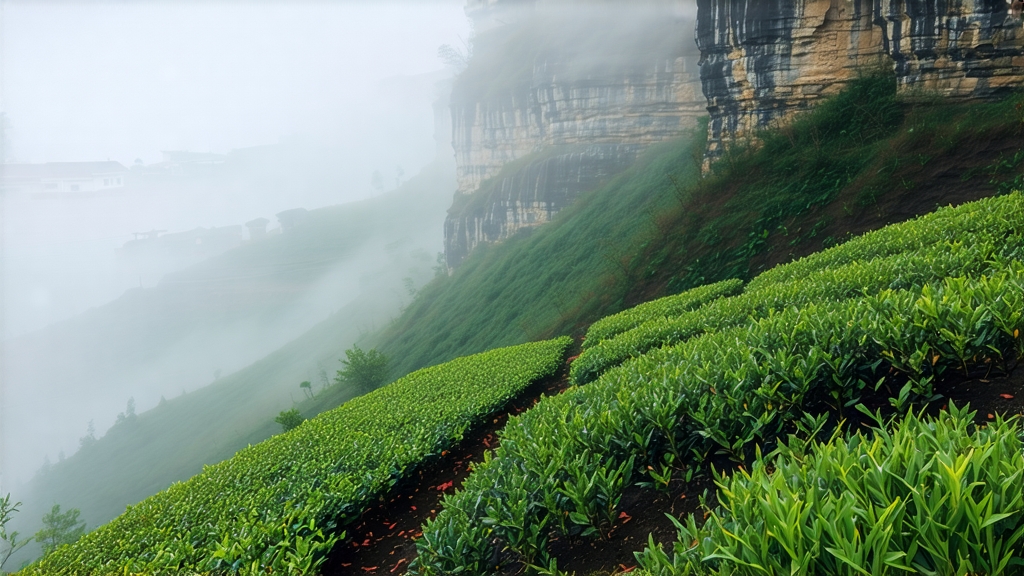
If green tea is the fresh face of Chinese tea culture and pu-erh its time-worn sage, then Wuyi Da Hong Pao stands somewhere between—an aristocrat with calloused hands, equally at home in imperial courts and mountain huts. Literally “Big Red Robe,” this oolong from the vertiginous Wuyi Mountains of northern Fujian carries a legend, a flavor, and a craftsmanship that have made it the benchmark for all “rock oolongs” (yancha). For international drinkers accustomed to the bright aromatics of Taiwanese high-mountain oolongs or the honeyed softness of Phoenix dancong, Da Hong Pao offers a darker, more mineral dialogue—one that tastes of stone, pine smoke, and the quiet power of centuries.
1. A legend carved on cliffs
The name first appears in Ming-dynasty county records, but folklore supplies the romance. A Ming emperor, stricken with illness en route to the imperial tombs, was revived by monks who brewed leaves plucked from six bushes clinging to a crevice above the Nine-Dragon Gorge. In gratitude he draped his vermillion court robe over the scraggly plants, conferring both color and imperial cachet. Whether apocryphal or not, the story fixed Da Hong Pao’s identity: tea so precious it warranted silk and sovereignty. The original “mother trees,” now protected by UNESCO and last harvested in 2006, still perch on Tianxin Rock, a living monument watched by CCTV cameras and guarded by local rangers.
2. Taxonomy in the rock garden
Da Hong Pao is simultaneously a cultivar, a commercial grade, and a blend. Purists speak of “Qidan,” the clonal offspring of the mother trees; farmers talk of “Beidou” and “QueShe,” two other Wuyi bushes genetically matched to the originals. Yet 99 % of what is sold as Da Hong Pao is a skillful marriage of several Wuyi cultivars—typically Rou Gui for spice, Shui Xian for body, and a touch of Qi Dan for pedigree—engineered by master blenders to recreate the “rock rhyme” (yanyun) that defines the category. In short, you may never taste the mother-tree tea unless you buy a 20-gram auction lot for the price of a car; what you can taste is the blended art that channels the same terroir.
3. Terroir: when granite breathes
The Wuyi range is a 550-million-year-old uplift of volcanic tuff and granite, eroded into gorges that trap humid subtropical air. Daytime temperatures on south-facing cliffs can reach 38 °C, dropping to 18 °C at night; the thermal swing forces slow polyphenol development. Rainwater percolates through fissures, picking up micronutrients that feed ancient root systems wedged into barely any soil. The resulting leaf is thick-walled, high in aromatic resins, and impregnated with minerals that translate into a tactile sensation Chinese tasters call “rock bone”—a mouth-watering, limestone-like minerality that lingers after the liquor is gone.
4. Craft: the eight stages of rock transformation
Plucking happens in late April, when three half-opened leaves and a bud are snipped with the nail, not the fingertip, to avoid bruising. The bushes are too inaccessible for machinery; every kilo travels down the mountain in wicker baskets on human backs.
- Withering: Leaves are spread on bamboo screens set into the cliff-side caves where reflected river mist provides 80 % humidity. Sun-withering lasts 20–30 minutes, enough to soften cell walls without oxidizing aromatics.
- Tumbling: The leaves are tossed in a rattan drum rotating at 18 rpm for 8 minutes, bruising edges to initiate oxidation while keeping the leaf center green.
- Oxidation: Resting on reed mats for 2–4 hours, the leaf temperature is monitored like bread dough; 30 % oxidation is the sweet spot that turns rims chestnut while preserving a jade core.
- Fixation: A 260 °C wok roast for 3 minutes denatures enzymes, locking in the partial oxidation that defines oolong.
- Rolling: The hot leaves are wrapped in cotton cloth and rolled into tight braids that will withstand later charcoal firing.
- Primary drying: 80 °C ovens reduce moisture to 20 %.